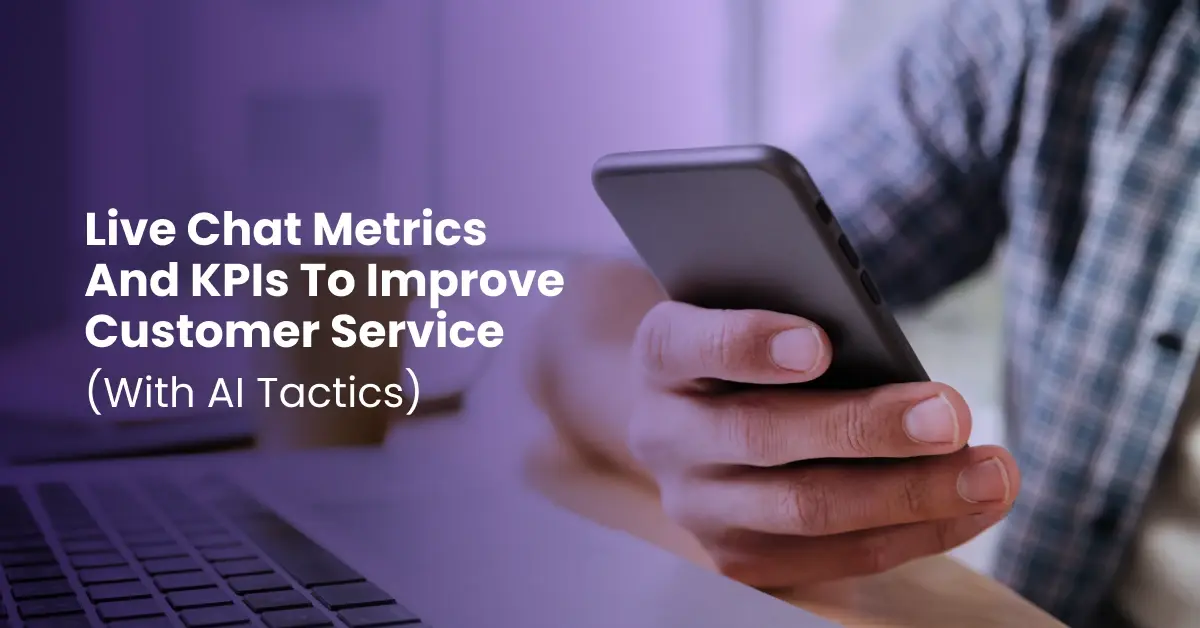Want better customer satisfaction and loyalty? Use these ten metrics to optimize your live chat support experience.
Monitoring and optimizing the following ten live chat metrics is an important step to improve your live chat performance. Use these customer support metrics to identify opportunities to improve the quantity and quality of your customer service.
How Live Chat Increases Opportunities
When customers land on your website, they probably have questions and concerns about doing business with you. When a question or worry pops into potential customers’ minds, you can connect with the potential buyer. While static website content like product descriptions and other pages lay a great foundation, there’s no replacement for having a conversation.
Once those conversations start flowing, measuring live chat performance is crucial. Also known as live chat performance metrics, metrics are essential for management. Regularly reviewing metrics will tell you where additional training or resources are needed to reach your goals.
With Live Chat, your employees can easily interact with your customers at scale while providing a personalized experience. That means you get greater customer loyalty. A high customer satisfaction rate means more return buyers and a positive impact on sales.
Two Ways To Use Generative AI To Improve Live Chat Effectiveness
Traditional methods to improve live chat KPIs or metrics are the foundation of your success. Agents need the right tools and training to carry out their work. Management needs good data to support their teams. After you have that foundation, generative AI tools (think chatGPT but business focused) can help.
1. Answer routine questions based on a knowledge base.
Do you have a knowledge base or a section of your website with frequently asked questions (FAQ)?
If so, generative AI tech can use that resource to provide company-specific responses to customers. This type of focused generative AI is developing, so now is a great time to investigate it for your business.
2. Provide product recommendations
Your live chat KPIs might emphasize customer support metrics. What if you could use live chat to improve revenue directly? That’s an exciting possibility with generative AI.
For example, add a live chat window to a product page and use it to provide specific product recommendations. This capability works well with products with straightforward, easy-to-describe differences (e.g., different types of TV have different sizes, resolution, and other features).
Arena AI Concierge for Publishers, Content & Affiliate Commerce is here. Request early access.
Ten Live Chat Metrics To Watch & How To Improve Each One!

Live chat metrics are only meaningful if they support your business goals. For example, you may aim to improve the effectiveness of your customer service agents by decreasing the average wait time by equipping your team with canned responses to common questions.
When you first start offering live chat, pick a few metrics to measure your performance. After those initial metrics are well integrated into your team, you can continue developing your systems by adding additional metrics to realize your chat strategy.
1. First Response Time (FRT) Live Chat Metric
The first live chat metric focuses on measuring the response speed. In brief, you measure how long your chat agents take to respond to a customer’s first message.
The FRP metric is critically important to impact your customers positively. A fast response tells your customers that you value their time. On the other hand, keeping a customer waiting for a long time is likely to hurt customer loyalty and word of mouth.
The first response time metric is also helpful for management. If FRT responsiveness decreases over time, it may signal that you need more chat agents. It may also indicate that your chat support teams need more support in the form of playbooks, frequently asked questions (FAQs), and other resources.
The average First Time Response is 15 minutes so you can use this timing as a starting point for your organization. In general, the lower this number, the better the customers’ satisfaction with the service. If the response takes more than the average, it will likely cause frustration and negative referrals.
Ways To Improve The FRP Metric
Tracking live chat key metrics becomes truly valuable when you use this data to improve performance. Use these tips to improve your live chat performance over time.
- Share FRP Metric Widely
Empower your employees by sharing FRP metrics widely and discussing them at each chat team meeting. Sharing live chat performance metrics with your team will help them become more innovative in improving the customer experience.
- Investigate FRP Metric Changes With An Open Mind
The FRP metric is helpful, but it has limitations. Like other chat customer service metrics, this measure doesn’t show the root cause of problems. Start by investigating technology problems that are interfering with service standards. In addition, chat responsiveness may suffer during periods of high volumes.
2. Total Number Of Chat Sessions Live Chat Metric
This live chat performance indicator is a volume measurement. It shows the number of live chat sessions that have been launched. Compared to other metrics for live chat, it is also relatively easy to track automatically. Tracking this metric is helpful over time; it shows the popularity of live chat for service vs. other customer service options like phone and email.
Ways To Improve The Total Volume of Chat Sessions Metric
Use the following metrics to get business value from this live chat metric.
- Look For Sharp, Sudden Drops In This Metric
A significant drop in the live metric is a warning sign that something is going wrong with your systems. That’s why we suggest monitoring this metric daily in normal conditions. You may want to track it hourly during times of peak usage.
- Ask For Feedback From Your Chat Agents.
The raw volume of chat conversations only tells you part of the picture. It is crucial to touch base with your live chat staff regularly. Ask them about the most common questions they face. Look for patterns in the questions you face so that you can create better answers and solutions for your chat agents to use.
3. Average Resolution Time (ART) Live Chat Metric
This live chat metric is adapted from the world of customer service call centers, unlike the first few live chat metrics. It is focused on the quality of your staff’s customer service.
It is not enough to provide a quick answer: ideally, the goal is to fully resolve a customer’s concern as efficiently as possible.
You generally want your average resolution time metric to be as low as possible. There is a risk of pressuring customer service staff to work too quickly. It is vital to ensure all of a customer’s concerns and questions are fully resolved and avoid cutting off the session simply to boost your chat performance metrics.
The ART metric is typically measured in minutes for most situations. Your ART metric might be days in some highly complex customer service cases.
Tips To Use The ART Metric Effectively
Use the following tips to interpret the ART metric effectively.
- Examine ART Metric Outliers
You can expect outliers to the ART metric. Consider cases where agents take much longer than average to resolve the question. For example, new customer support employees might take longer to resolve issues. In that case, the higher ART time is understandable and will likely decline.
On the other hand, keep an eye on the chat load that your experienced chat operators have. If your experienced staff have an excessive workload, customers are more likely to have a bad experience.
- Validate ART With Other Customer Service Channels
Your company probably has multiple customer service channels like phone calls, email, and in-person locations. If live chat ART data looks great, comparing it to your other support options, like the phone center, is helpful. Ideally, you want to see consistent levels of customer service resolution across your critical channels.
4. Chat to Conversion Rate Live Chat Metric
To become a chat leader, it’s essential to convert chat participants into buyers. According to our research, 38% of customers who participate in a live chat session ultimately decide to purchase after receiving excellent support front the customer service team.
This chat experience metric may be the most valuable metric we have covered. It tells you how effectively the chat channel produces revenue or leads. Now, let’s look at ways you can help the customer service team convert more chat participants into leads and customers.
Tips To Raise Your Chat To Conversation Rate Live Chat Metric
- Use Analytics To Find What’s Working
Not all chat requests are created equal. For example, compare a chat that starts on your home page with a chat on the checkout page. Generally, converting a website visitor to a buyer on certain pages (e.g., a product page) is easier.
When you connect your chat platform to a customer data platform, for example, your chat team leaders may find out that one individual agent has an above-average score when it comes to converting visitors to buyers. In that case, reach out to that person and find out what they are doing. Based on what you learn, develop additional training for your staff.
- Improve The Customer Experience With Technology
Additional training is not the only way to enhance the chat experience. For example, take a critical look at your chat software. Your current software may not be able to handle the number of inbound chats you are receiving. Or your software may not load in an acceptable time. Switching to a faster chat tool like Arena Live Chat can improve your customer experience almost overnight.
5. First Contact Resolution Rate (FCR) Live Chat Metric
The FCR rate is a critical quality metric. Your customer’s concerns in a single chat session in ideal conditions. It is unrealistic to expect that you will be able to solve 100% of customer complaints or questions on the first attempt. Setting a high bar for this metric is wise to maintain customer happiness.
To calculate the First Contact Response rate, you must track the number of interactions in a case and the proportion of one-touch resolutions. Track this data for at least one month before attempting to improve.
Traditionally, contact centers aim for a 70% FCR rate. Reaching this level of success is easier when your chat team has access to extensive resources like proper answers to commonly asked customer questions. If your first contact resolution rate is lower right now, use the following tips to work with chat team staff to improve.
Tips To Improve Your First Contact Resolution Rate
- Send A Customer Survey After The Chat Session
Sending a short customer survey with a few simple questions is a great way to gather feedback from your customer base. For example, ask your customers to rate their satisfaction level on a scale of 0 to 10. If the score is below 5, ask a follow-up question about it.
- Assess Your Chat Queue Data
When customers have to wait a long time, they may be more upset when the chat session starts. As a result, a long chat queue can make it more challenging to solve customer questions quickly. Better training and a high-performance chat system can help here.
6. Customer Satisfaction Score (CSAT) Live Chat Metric
The CSAT is one of the most popular ways to develop a customer satisfaction rating for customer support. A customer satisfaction score (CSAT) measures how much your product or service meets or surpasses your customer’s expectations. A short customer satisfaction survey at the end of the live chat session is all you need to achieve this metric.
How To Improve The CSAT Score
There are a few popular ways to improve. Use these tips to boost your chat quality assurance efforts.
- Find High Chat Satisfaction Cases
Studying chat transcripts from successful interactions is an excellent way to improve your performance. Look at how your high-performing employees are addressing common customer pain points. Once you identify these best practices, share them with the rest of your team.
- Identify Patterns In Low CSAT Scores
Persistent low CSAT scores warn that something is wrong in your business. Before creating an action plan, take the time to understand the problem entirely. Look at contact volumes, peak traffic hours, and recent business growth. Your chat staff may be doing their best to help customers but simply lack the resources to serve customers effectively.
7. Net Promoter Score (NPS) Live Chat Metric

NPS might be one of the best pieces of information to evaluate customer satisfaction metrics. This metric measures overall customer loyalty, not just the chat experience.
The NPS process is simple. You gather consistent customer feedback by asking them a single question: On a scale of 0-10, how likely are you to recommend our company to other people you know?
The NPS methodology breaks down scores into three categories:
- The Detractors (0 – 6)
- The Passives (7 and 8)
- The Promoters (9 and 10)
Ideally, you want to maximize promoters and minimize the other two categories as much as possible. Use the tips covered elsewhere in this guide to improve your customer experience. Remember that customers can respond negatively to an NPS question for several reasons (e.g., upset with product delivery, pricing, etc.) that have nothing to do with the quality of their chat interaction.
8. Average Wait Time Live Chat Metric
Think about the last time you contacted a company with a question. Did you enjoy waiting for an answer? Even loyal customers hate waiting. That’s why monitoring your average wait time is a crucial metric.
The average chat wait time is usually less than a few minutes. Of course, this metric may look different during your busiest hours when you have a high volume of incoming chats.
There are a few options to improve the average time it takes to respond to customers. Start with examining the resources your chat agents have. Equipping your staff with canned answers, detailed product information, shipping details, and related resources can make a big difference.
While prewritten responses are helpful, they have limitations. You don’t want your customers to feel ignored simply because your chat staff feels pressured to achieve better chat performance benchmarks. This chat metric must be interpreted alongside other metrics, such as the NPS and FCR rate.
9. Website Visitors To Chats Metric
Increasing the number of chats per month generated from your website is a worthwhile goal to pursue. Most of the time, more chat sessions lead to more sales and more satisfied customers.
Keeping track of this metric is easy because you can easily track the data required. As a starting point, aim for a 1% conversion rate. If your website has 100,000 visitors per month, you should expect to have 1,000 chat sessions per month.
This metric is more valuable when read in the context of other metrics. For example, it is crucial to maintain high levels of customer satisfaction (e.g., high NPS rates, high first contact resolution rates, etc.) even as you lift.
Ways To Improve This Metric
There are a few techniques you can use to improve this metric.
- Use A Better Chat Tool
The right chat technology has an important role in lifting this metric. For example, Arena Live Chat is built for speed and usability. Arena can also support a large volume of chat sessions simultaneously.
- Optimize Your Chat Session Prompt
Chat windows usually start with a message or a question. Experimenting with different questions (e.g., “Do you have any questions?” vs. “Do you have a question about our Black Friday sale?”) can increase the number of website visitors who start a chat session.
10. Missed Chats Live Chat Metric
The missed live chat metric gives insight into whether your chat team can keep up with incoming chat requests.
A single experienced live chat agent can handle approximately 6 to 7 simultaneous conversations if they are relatively simple. Once your chat team hits capacity, missed chats will become a problem.
It’s not just a question of workload influencing this metric. You may also face a mismatch between working hours and staff availability. Your website is open 24/7 for business, but your chat support team is only available between 9 am to 5 pm.
Therefore, the raw volume of missed chats is only part of the story. It is also essential to track when missed chat requests occur. If missed chat sessions occur during regular working hours, use the other techniques mentioned in other parts of this situation.
Ways To Improve The Missed Chats Live Metric
Improving your performance on this live chat metric can be relatively challenging.
- Manage Expectations For Non-Business Hours Service
When you have a significant chat volume outside your usual work hours, give your customers other options. For example, show your customer service email address and invite customers to message your team.
- Extend Chat Service Hours At Peak Periods
Chat handling time and chat volume will likely increase when you run sales. In those cases, average response time and missed chat measures may suffer. To avoid this problem, ask more employees to work as customer support agents to handle the demand.
How To Go Beyond Standard Customer Service Chat
You may already have a chat app in place for day-to-day needs. But, what about events like live shopping, livestreams and other virtual events? These events are an exciting way to launch products and bring your community together. In these situations, a different chat solution is needed.
Arena Live Chat is the perfect solution for digital events because your customers can message each other, ask support questions and build trust with your brand. Learn more about Arena’s capabilities today.



